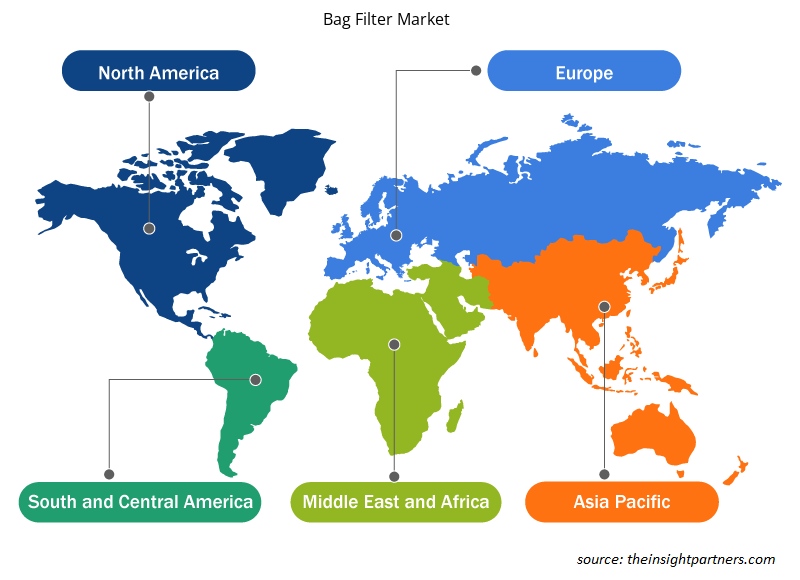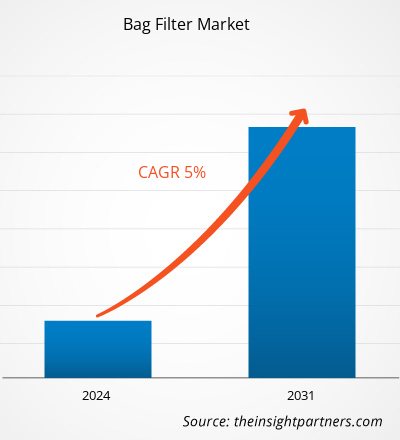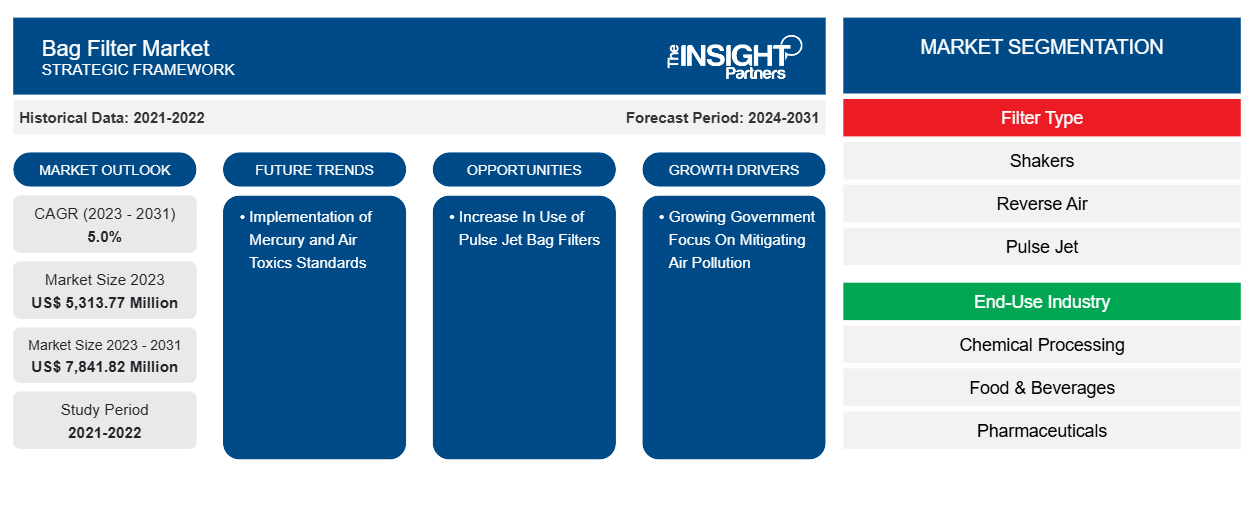Si prevede che la dimensione del mercato dei filtri a sacco raggiungerà i 7.841,82 milioni di dollari entro il 2031, rispetto ai 5.313,77 milioni di dollari del 2023. Si prevede che il mercato registrerà un CAGR del 5,0% nel periodo 2023-2031. È probabile che l'applicazione di standard di mercurio e sostanze tossiche nell'aria rimanga una tendenza chiave nel mercato.
Analisi di mercato dei filtri a sacco
Gli alloggiamenti dei filtri a sacco utilizzati nell'industria mineraria e chimica hanno spesso un marchio ASME e devono essere realizzati in acciaio inossidabile. Il processo di filtrazione deve in genere rispettare requisiti rigorosi e spesso essere in grado di filtrare particelle più piccole di un micron. I filtri a sacco funzionali hanno in genere un'efficienza di raccolta delle particelle del 99% o superiore, indipendentemente dalle dimensioni estremamente piccole delle particelle, a differenza dei precipitanti elettrostatici, le cui prestazioni possono variare notevolmente a seconda del processo e delle condizioni elettriche. Alcuni filtri a sacco sono dotati di corna ultrasoniche che producono vibrazioni aggiuntive per migliorare la rimozione della polvere. Le corna vengono attivate poco prima o all'inizio del ciclo di pulizia per aiutare a rompere i legami tra le particelle sulla superficie del mezzo filtrante. Sono state implementate diverse nuove restrizioni nei paesi sviluppati del Nord America e dell'Europa occidentale per limitare le emissioni industriali dannose. Frequenti cambiamenti nelle leggi richiedono frequenti ammodernamenti o aggiornamenti dei sistemi di filtri a sacco negli impianti industriali.
Panoramica del mercato dei filtri a sacco
Sono disponibili sul mercato diverse configurazioni di filtri a sacco, progettate in modo unico per soddisfare le esigenze operative. Dai filtri a sacco standard ai prodotti progettati su misura, i produttori forniscono diversi tipi di prodotti ai propri clienti. Grazie al loro basso costo e all'elevato livello di affidabilità, i filtri a sacco industriali sono spesso utilizzati nell'industria alimentare e delle bevande. L'osmosi inversa o i filtri a sacco con carbone attivo sono ampiamente utilizzati per purificare l'acqua dalle impurità.
Personalizza questo report in base alle tue esigenze
Riceverai la personalizzazione gratuita di qualsiasi report, comprese parti di questo report, o analisi a livello nazionale, pacchetto dati Excel, oltre a usufruire di grandi offerte e sconti per start-up e università
-
Scopri le principali tendenze di mercato in questo rapporto.Questo campione GRATUITO includerà analisi di dati che spaziano dalle tendenze di mercato alle stime e alle previsioni.
Driver e opportunità del mercato dei filtri a sacco
Crescente attenzione del governo alla mitigazione dell’inquinamento atmosferico per favorire il mercato
Con l'obiettivo di ridurre l'impatto delle emissioni industriali e di ridurre il livello di emissione del settore industriale, i governi di vari paesi stanno stabilendo leggi e regolamenti per mitigare l'inquinamento atmosferico. Il crescente sviluppo e l'espansione del settore industriale insieme alla crescente urbanizzazione dovrebbero aumentare il livello di inquinamento atmosferico, che ha un impatto diretto sulla salute e aumenta il numero di malattie trasmesse per via aerea. Pertanto, la crescente attenzione del governo nel ridurre i livelli di inquinamento atmosferico sta indirizzando l'attenzione del governo nell'implementazione di rigide politiche sul settore industriale, che sta guidando la domanda di filtri a sacco a livello globale.
Aumento dell'uso di filtri a sacco Pulse Jet
Per soddisfare le esigenze di sicurezza della qualità dell'aria sul posto di lavoro, i filtri a sacco a getto d'aria pulsato sono uno dei tipi di apparecchiature di controllo dell'inquinamento atmosferico più popolari . I collettori di polvere a getto d'aria pulsato sono progettati principalmente per catturare e ridurre efficacemente il particolato e le emissioni potenzialmente tossiche. L'efficienza dei filtri a getto d'aria pulsato sta aumentando la sua applicazione a livello globale.
Analisi della segmentazione del rapporto di mercato dei filtri a sacco
I segmenti chiave che hanno contribuito alla derivazione dell'analisi di mercato dei filtri a sacco sono il tipo di filtro e il settore di utilizzo finale.
- In base al tipo di filtro, il mercato dei filtri a sacco è suddiviso in shaker, reverse air e pulse jet. Il segmento pulse jet ha detenuto una quota di mercato maggiore nel 2023.
- In base al settore di utilizzo finale, il mercato è segmentato in lavorazione chimica, alimenti e bevande, prodotti farmaceutici, carta e cellulosa, trattamento delle acque e altri. Il segmento della lavorazione chimica ha detenuto una quota significativa del mercato nel 2023.
Analisi della quota di mercato dei filtri a sacco per area geografica
L'ambito geografico del rapporto di mercato sui filtri a sacco è suddiviso principalmente in cinque regioni: Nord America, Asia Pacifico, Europa, Medio Oriente e Africa, e Sud e Centro America.
Il Nord America è leader di mercato. Gli Stati Uniti sono leader di mercato per i filtri a sacco in Nord America. Il crescente sviluppo nel settore industriale e la crescente attenzione del governo nel mitigare il livello di inquinamento atmosferico dal settore industriale stanno guidando la crescita del mercato dei filtri a sacco in Nord America. Nazioni come Regno Unito, Francia, Germania e Belgio sono i pochi paesi con un numero maggiore di industrie chimiche e F&B, che stanno guidando la crescita in tutta Europa. Il crescente numero di impianti di trattamento delle acque e delle acque reflue nell'Asia Pacifica sta avendo un impatto positivo sul mercato dei filtri a sacco in tutta l'Asia Pacifica.
Approfondimenti regionali sul mercato dei filtri a sacco
Le tendenze regionali e i fattori che influenzano il mercato dei filtri a sacco durante il periodo di previsione sono stati ampiamente spiegati dagli analisti di Insight Partners. Questa sezione discute anche i segmenti e la geografia del mercato dei filtri a sacco in Nord America, Europa, Asia Pacifico, Medio Oriente e Africa e Sud e Centro America.

- Ottieni i dati specifici regionali per il mercato dei filtri a sacco
Ambito del rapporto di mercato sui filtri a sacco
| Attributo del report | Dettagli |
|---|---|
| Dimensioni del mercato nel 2023 | 5.313,77 milioni di dollari USA |
| Dimensioni del mercato entro il 2031 | 7.841,82 milioni di dollari USA |
| CAGR globale (2023-2031) | 5,0% |
| Dati storici | 2021-2022 |
| Periodo di previsione | 2024-2031 |
| Segmenti coperti |
Per tipo di filtro
|
| Regioni e Paesi coperti |
America del Nord
|
| Leader di mercato e profili aziendali chiave |
|
Densità degli attori del mercato: comprendere il suo impatto sulle dinamiche aziendali
Il mercato dei filtri a sacco sta crescendo rapidamente, spinto dalla crescente domanda degli utenti finali dovuta a fattori quali l'evoluzione delle preferenze dei consumatori, i progressi tecnologici e una maggiore consapevolezza dei vantaggi del prodotto. Con l'aumento della domanda, le aziende stanno ampliando le loro offerte, innovando per soddisfare le esigenze dei consumatori e capitalizzando sulle tendenze emergenti, il che alimenta ulteriormente la crescita del mercato.
La densità degli operatori di mercato si riferisce alla distribuzione di aziende o società che operano in un particolare mercato o settore. Indica quanti concorrenti (operatori di mercato) sono presenti in un dato spazio di mercato in relazione alle sue dimensioni o al valore di mercato totale.
Le principali aziende che operano nel mercato dei filtri a sacco sono:
- Società anonima Babcock & Wilcox Enterprises Inc.
- BWF Offermann, Waldenfels & Co. KG
- Camfil
- Società Danaher
- Società per azioni Donaldson Company, Inc.
- Società Eaton
Disclaimer : le aziende elencate sopra non sono classificate secondo un ordine particolare.

- Ottieni una panoramica dei principali attori del mercato dei filtri a sacchetto
Notizie di mercato e sviluppi recenti sui filtri a sacco
Il mercato dei filtri a sacco viene valutato raccogliendo dati qualitativi e quantitativi dopo la ricerca primaria e secondaria, che include importanti pubblicazioni aziendali, dati associativi e database. Di seguito sono elencati alcuni degli sviluppi nel mercato dei filtri a sacco:
- Parker Hannifin Corp. ha lanciato un filtro a maniche pieghettato da utilizzare in applicazioni con calore estremo. (Fonte: Parker Hannifin Corp, comunicato stampa, maggio 2022)
- Babcock & Wilcox acquisisce FPS. L'acquisizione di Fossil Power Systems, Inc., un rinomato produttore di gas naturale, idrogeno e apparecchiature per la combustione di cellulosa e carta rinnovabili, è stata annunciata da Babcock e Wilcox Enterprises, Inc. (Fonte: Babcock & Wilcox, comunicato stampa, febbraio 2022)
Copertura e risultati del rapporto sul mercato dei filtri a sacco
Il rapporto "Dimensioni e previsioni del mercato dei filtri a sacco (2021-2031)" fornisce un'analisi dettagliata del mercato che copre le seguenti aree:
- Dimensioni e previsioni del mercato dei filtri a sacco a livello globale, regionale e nazionale per tutti i principali segmenti di mercato coperti dall'ambito
- Tendenze del mercato dei filtri a sacco e dinamiche di mercato come driver, restrizioni e opportunità chiave
- Analisi PEST e SWOT dettagliate
- Analisi di mercato dei filtri a sacco che copre le principali tendenze del mercato, il quadro globale e regionale, i principali attori, le normative e i recenti sviluppi del mercato
- Analisi del panorama industriale e della concorrenza che copre la concentrazione del mercato, l'analisi della mappa di calore, i principali attori e gli sviluppi recenti per il mercato dei filtri a sacco
- Profili aziendali dettagliati
- Analisi storica (2 anni), anno base, previsione (7 anni) con CAGR
- Analisi PEST e SWOT
- Valore/volume delle dimensioni del mercato - Globale, Regionale, Nazionale
- Industria e panorama competitivo
- Set di dati Excel
Report recenti
Testimonianze
Motivo dell'acquisto
- Processo decisionale informato
- Comprensione delle dinamiche di mercato
- Analisi competitiva
- Analisi dei clienti
- Previsioni di mercato
- Mitigazione del rischio
- Pianificazione strategica
- Giustificazione degli investimenti
- Identificazione dei mercati emergenti
- Miglioramento delle strategie di marketing
- Aumento dell'efficienza operativa
- Allineamento alle tendenze normative























 Ottieni un campione gratuito per - Mercato dei filtri a sacco
Ottieni un campione gratuito per - Mercato dei filtri a sacco